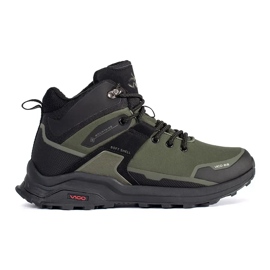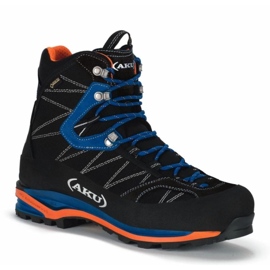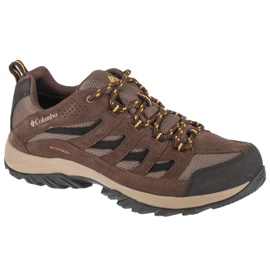Men's trekking shoes - a reliable partner on the trail
Why choose the right men's trekking shoes?
Going on mountain trails, hiking or long journeys, it is important to have the right footwear. Men's trekking shoes are not only a matter of convenience, but above all safety. Good shoes ensure stability on uneven terrain, protect the feet against injuries and overloads, and also drain moisture, which prevents chafing and prints. We should think about choosing the right shoes not only in terms of aesthetics, but above all functionality and adaptation to individual needs and field conditions. A properly selected model can significantly affect the quality and pleasure of traveled routes, minimizing the risk of injury and increasing comfort during long hours on the legs.
Types of male trekking shoes and their purpose
There are many types of men's trekking shoes on the market, which differ in their purpose, construction and level of advancement. The most popular are hiking shoes, designed for short walks and mild routes, characterized by lightweight construction and good breathability. In turn, mountain shoes are models designed for more difficult terrain conditions, often with waterproof elements, reinforcements and a solid sole. Among them, we also distinguish high, semi -hyply and low models, depending on the needs and preferences of the user. It is important to match the type of shoe to the planned route and the environment in which we will move.
Key features of good male trekking shoes
Good men's trekking shoes must have a number of features that translate into comfort and safety of use. First of all, water resistance is important, which protects the feet from wetting in the rain or when crossing wet areas. It is also important to fit, which will not compress, but at the same time it will not be too loose. Proper cushioning allows you to reduce the feeling of shocks and longer durability to long routes. The sole design should provide good adhesion and stability on various surfaces. Additional elements, such as lacing systems, finger reinforcements or ventilation systems, increase the functionality of shoes and increase the comfort of use.
How to choose the right size of men's trekking shoes?
Choosing the right size of men's trekking shoes is crucial for comfort and prevention of injuries. When measuring, it is worth remembering to leave the space on your fingers-about 1-1.5 cm from the end of the shoe to the end of the longest finger. When choosing, you should also be guided by the width of the foot, not just a number, because the differences between the brands can be significant. A good solution is to try on footwear under load or in trekking socks that will be used on the route. Remember that well -fitted shoes should not compress or cause bruising, but at the same time they have to hold the foot well to avoid moving during the journey.
Material of making male trekking shoes
The material from which men's trekking shoes are made is crucial for their durability, waterproof and breathability. Most often, natural leather is used, which is characterized by high durability and resistance to damage, as well as synthetic fabrics, which are lighter and more breathing. Models connecting these two materials are also popular, ensuring optimal parameters. Waterproof coatings and membranes, such as gore-tex, increase moisture resistance, while allowing sweat evaporation. It is worth choosing models that are resistant to abrasion and have reinforcements in sensitive places to serve for many seasons.
Sole: a key element of trekking shoes
The sole is one of the most important elements of men's trekking shoes. Properly selected ensures adhesion, stability and cushioning in difficult terrain. It is worth choosing models with a deep tread that acts like handles on uneven surfaces, minimizing the risk of slipping. The soles made of high quality rubber are characterized by good flexibility and durability. Some models use soles with a multi -layered construction, combining various materials that improve comfort and abrasion resistance. It is also good to pay attention to vulcanization and strengthening systems that increase shoes.
Lacing systems and foot support
Effective lacing systems are another important element of men's trekking shoes. They can have different systems and the number of stitches, affecting the fit and stabilization of the foot. Advanced models are offered by lock systems that allow you to accurately adjust and quickly adjust the voltage. Support for the arch and stabilization of the heel are elements that protect against injuries and increase comfort on long routes. It is worth choosing shoes with systems that allow even tone of the shoelaces, preventing pressure and feeling of discomfort during hiking.
Additional elements and accessories for men's trekking shoes
Various accessories and accessories are also available on the market that can improve the functionality of men's trekking shoes. These include, for example, orthopedic inserts, replaceable inserts that can increase comfort or adapt shoes to individual needs. Nasting covers, trekking stick holders or finger pads are further elements that can be mounted to increase the protection and functionality of the footwear. In addition, special impregnants and preservatives help maintain the properties of materials and extend the life of the shoes. The correct selection and use of accessories can significantly affect comfort during difficult terrain conditions.
Summary: How to choose the perfect men's trekking shoes
Choosing the right male trekking shoes is a key decision that will affect the comfort, safety and satisfaction of each trip. You should be guided by individual needs, the type of area where we will move and weather conditions. It is important to pay attention to the material, soles design, lacing system and matching. Remember that investing in good quality footwear is a guarantee of longer durability and better experience on the trail. Properly selected men's trekking shoes are a reliable partner who will be up to the challenge, regardless of the challenges that the adventure will be brought in the mountains or on mountain paths.










![Aku Trekker Pro Gore-Tex trekking shoes [844020] brown Aku Trekker Pro Gore-Tex trekking shoes [844020] brown](https://keeshoes.com/a/ale/auction_image/image1_225630.s270/aku-trekker-pro-gore-tex-trekking-shoes-844020-brown-270x270.jpeg?_=1749067065.9486248)







![Men's trekking shoes Aku Libra Plus [774.1 052] black Men's trekking shoes Aku Libra Plus [774.1 052] black](https://keeshoes.com/a/ale/auction_image/image1_225485.s270/mens-trekking-shoes-aku-libra-plus-774-1-052-black-270x270.jpeg?_=1747325161.5011571)
![Men's trekking shoes Aku Nativa Canvas [646 016] blue Men's trekking shoes Aku Nativa Canvas [646 016] blue](https://keeshoes.com/a/ale/auction_image/image1_225484.s270/mens-trekking-shoes-aku-nativa-canvas-646-016-blue-270x270.jpeg?_=1747324226.78030231)









